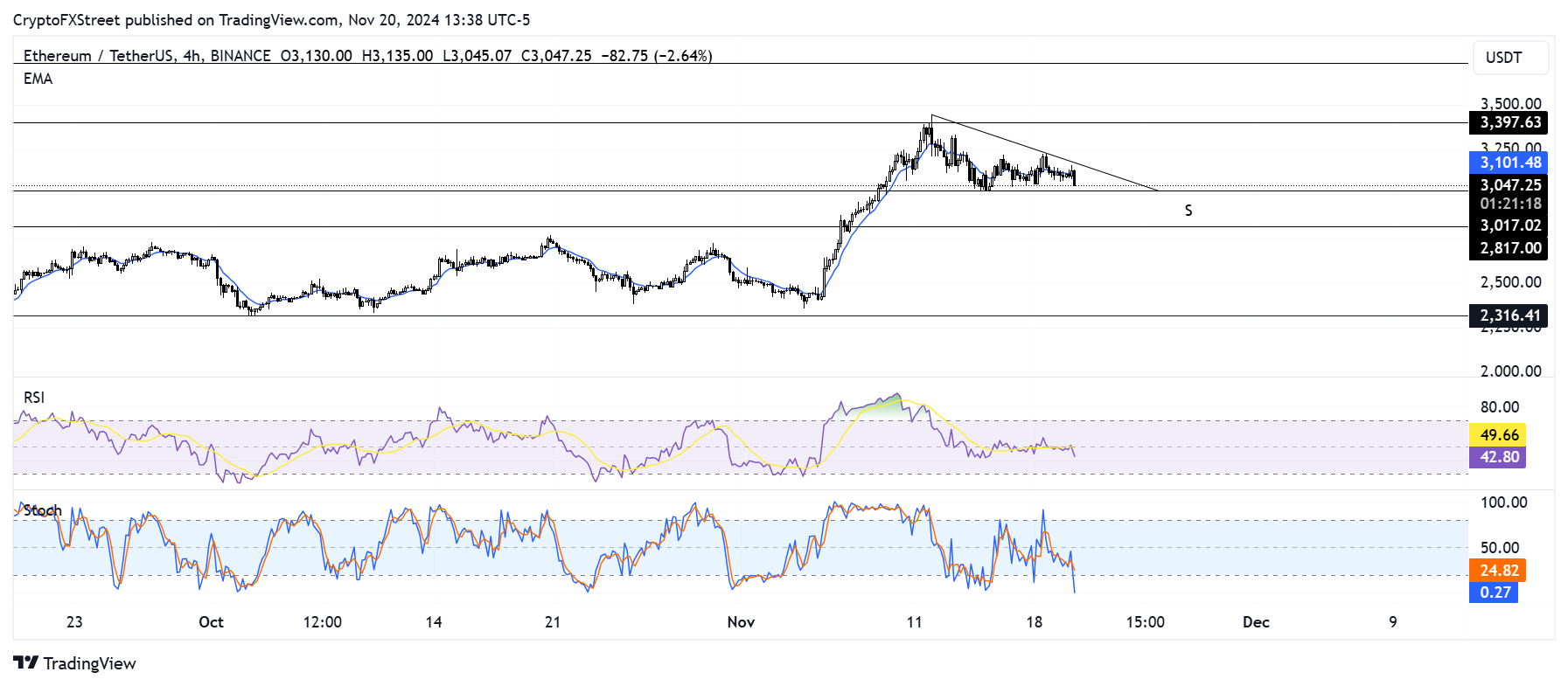Ethereum price today: $3,040
- Ethereum investors recorded $230 million in gains and $141 million in realized losses from selling activity in the past two days.
- ETH’s underperformance compared to other top altcoins indicates that the selling pressure stems from investors rotating into these tokens.
- ETH could decline by 23% if it confirms a descending triangle pattern by moving below the $3,000 psychological level.
Ethereum (ETH) trades near $3,040 on Wednesday as on-chain data reveals a mix of capitulation and profit-taking among long-term holders. The selling pressure stems from investors potentially rotating into other better-performing altcoins in the past week.
Ethereum investors could be rotating into other alts
On-chain data shows that Ethereum is facing rising selling pressure after investors realized losses of $141.3 million on Tuesday — their highest since September 10. On the other hand, a few investors also sold in the past few hours to book profits of about $230 million.
%20%5B18.41.13,%2020%20Nov,%202024%5D-638677266345845720.png)
ETH Network Realized Profit/Loss | Santiment
The ETH Age Consumed metric, which tracks the movement of previously idle ETH tokens, also saw notable spikes in the past two days, indicating most of the recent selling activity is potentially from long-term holders.
The chart below, which shows ETH’s mean coin age across several age bands, reveals that most of the selling activity comes from coins within the one to three-year cohort.
%20%5B19.25.23,%2020%20Nov,%202024%5D-638677266900354534.png)
ETH Mean Coin Ages | Santiment
While the selling pressure isn’t yet strong enough to cause a wide price swing, it’s important to pay attention to changes in these metrics in the coming days.
A potential reason for the selling pressure could be investors rotating into other altcoins that have seen increased bullish momentum in the past week.
Unlike previous cycles where investors rotated from Bitcoin into Ethereum and then other altcoins, sustained increased institutional interest in the top digital asset has flipped the script.
As a result, the on-chain metrics explored earlier show that ETH could be the coin suffering from rotation. Its performance compared to other top altcoins in the past week supports this thesis. On the weekly time frame: ETH (-6%), Solana (6%), XRP (51%), Cardano (39%), TRX (8%), SUI (7%), Polkadot (7%) and Stellar (86%).
Meanwhile, Ethereum exchange-traded funds (ETFs) recorded a fourth-consecutive day of negative flows with net outflows of $81.3 million on Tuesday, per Coinglass data.
Ethereum Price Forecast: ETH could decline by 23% if descending triangle pattern is validated
Ethereum is down 2% after sustaining $47.88 million in liquidations in the past 24 hours. Liquidating long and short positions accounted for $34.71 million and $13.17 million, respectively.
On the 4-hour chart, ETH is trending downward toward the $3,000 psychological level. After posting a series of lower highs and lower lows, the top altcoin’s recent move is following a descending triangle pattern.

ETH/USDT 4-hour chart
As a result, if ETH declines below the $3,000 psychological level, it could take a 23% dive to the support level near $2,300. However, the $2,817 key level, which bulls defended for nearly four months between April and July, could help prevent such a sharp decline.
The Relative Strength Index (RSI) is slightly below its neutral level, indicating bearish momentum is moderately dominant.
The Stochastic Oscillator is in the oversold region, indicating strong bearish pressure and potential for a brief recovery.
A daily candlestick close above $3,400 will invalidate the bearish thesis.
Ethereum FAQs
Ethereum is a decentralized open-source blockchain with smart contracts functionality. Its native currency Ether (ETH), is the second-largest cryptocurrency and number one altcoin by market capitalization. The Ethereum network is tailored for building crypto solutions like decentralized finance (DeFi), GameFi, non-fungible tokens (NFTs), decentralized autonomous organizations (DAOs), etc.
Ethereum is a public decentralized blockchain technology, where developers can build and deploy applications that function without the need for a central authority. To make this easier, the network leverages the Solidity programming language and Ethereum virtual machine which helps developers create and launch applications with smart contract functionality.
Smart contracts are publicly verifiable codes that automates agreements between two or more parties. Basically, these codes self-execute encoded actions when predetermined conditions are met.
Staking is a process of earning yield on your idle crypto assets by locking them in a crypto protocol for a specified duration as a means of contributing to its security. Ethereum transitioned from a Proof-of-Work (PoW) to a Proof-of-Stake (PoS) consensus mechanism on September 15, 2022, in an event christened “The Merge.” The Merge was a key part of Ethereum’s roadmap to achieve high-level scalability, decentralization and security while remaining sustainable. Unlike PoW, which requires the use of expensive hardware, PoS reduces the barrier of entry for validators by leveraging the use of crypto tokens as the core foundation of its consensus process.
Gas is the unit for measuring transaction fees that users pay for conducting transactions on Ethereum. During periods of network congestion, gas can be extremely high, causing validators to prioritize transactions based on their fees.
























